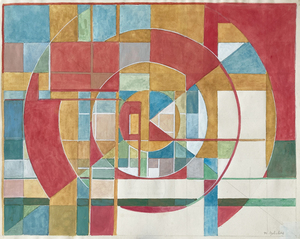Maurice Golubov
Maurice Golubov was born in Vetka, Russia to Orthodox Jewish parents who envisioned their son becoming a Rabbi. The young Maurice was steeped in Yiddish, Hebrew, the Talmud and medieval Jewish Mysticism, which had a life-long influence on his career. As a boy of six he found a copy of Gustave Doré's Bible from 1891 and was enthralled, making copies with the luscious illustrations where-in the biblical inhabitants were often minus clothing. His mother was appalled and he was punished but it set his future in which he always pursued the duality of figuration and abstraction.
In 1914 his mother decided to take the family to New York, where his father was already established. The journey was long and arduous. At one point Maurice got separated from his family and spent harrowing months among "wild children" before miraculously finding his family again in Petrograd. They eventually arrived in New York in late 1917.
In New York, he first studied art during evening classes with John Sloan at a Hebrew Educational Society settlement house where Mark Tobey introduced him to the National Academy of Design where, in 1922, he received the Suydam Silver Medal for excellence in life drawing. At the time, Golubov had never seen a modern or avant-garde artwork, yet in class he began making small abstractions in the margins of his school work. He was trying to fulfill a curiosity he’d had since childhood, to make a visual representation of the invisible world he could sense and feel — things that were real and yet unseen. He would eventually develop this into his concept of the Fourth Dimension. He eventually discovered New York museums and by the late 1920s, he had discovered Kandinsky, Picasso, and Cézanne on his roster of revered masters. He became friendly with a number of other artists — Max Weber, Stuart Davis, and Arshile Gorky, Milton Avery, and David Smith. By the late 1930s he continued to move between abstraction and figuration. In 1941 Golubov had a solo exhibition at the Artists’ Gallery where Alice Mason and George L.K. Morris saw the show and invited im to join the American Abstract Artists. By the late 1940s, most of Golubov’s work was abstract. He showed in group exhibitions at the Walker Art Center, the Jewish Museum, the Museum of Modern Art, and the Whitney Museum of American Art. In 1943 and 1952, he had solo shows at the Mint Museum in Charlotte, North Carolina. Betty Parsons gave him a solo show at the Mortimer Brandt Gallery. In 1962 Golubov’s work was featured in Recent Painting USA: The Figure at the Museum of Modern Art. In 1975 he began representation with Tibor de Nagy Gallery in New York and in 1980 was given his first major museum retrospective at the Mint Museum, ending at the Jewish Museum. He was 75 years old.














